Managing process improvements in government agencies is no easy feat. Whether you’re focused on identifying customer needs and performance problems, managing organizational changes, reassessing strategic goals, or controlling risks and maximizing benefits, business improvements can always present a challenge. Without taking the right steps, reengineering work activities and tasks may even fail.
Before you can implement change, it’s critical to break down your current operations and identify what needs to be upgraded. Let’s assess how business process reengineering efforts can create new opportunities for your agency to reap the benefits of redesigning existing processes and turning them into flexible, innovative functions.
In This Article
- What Is Business Process Reengineering?
- How Business Process Reengineering Can Benefit Your Government Agency
- Reduce Costs by Eliminating Unproductive Activities
- Accelerate Information Access to the Right People
- Make Your Team More Flexible
- Improve the Quality of Your Service
- Enable Innovation
- Support Your Project Goals
- Provide Clarity of Purpose
- Increase Operational Efficiency
- Amplify Transparency and Consistency
- Maximize Your ROI
- How to Get Started With Government Process Reengineering
- Start Evaluating Your Agency’s Processes Today
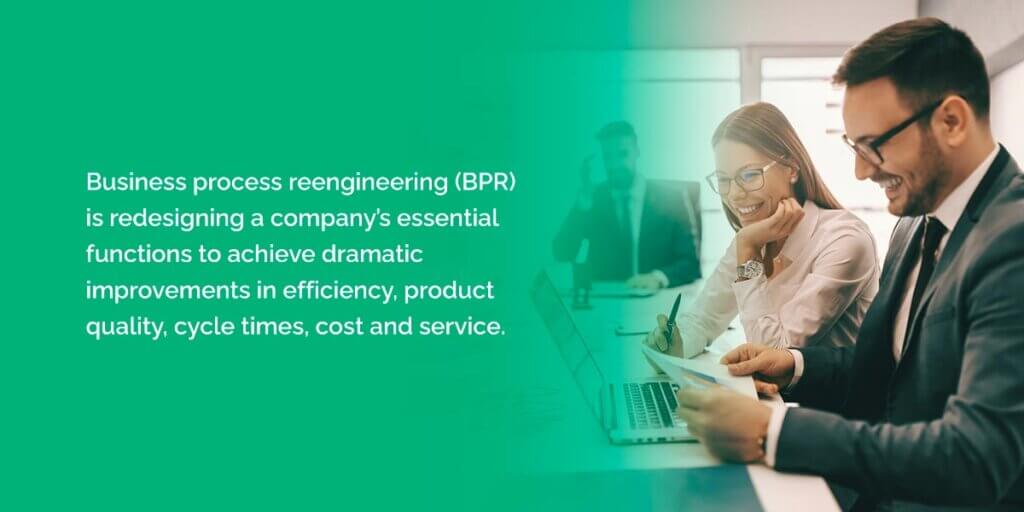
What Is Business Process Reengineering?
Business process reengineering (BPR) is redesigning a company’s essential functions to achieve dramatic improvements in efficiency, product quality, cycle times, cost, and service. This strategy is sometimes called business process redesign, business transformation, or business process change management.
Businesses and government agencies use this process to reduce enterprise costs and redundancies across the organization, often due to reasons such as:
- Increasing competition
- Performance problems
- New market opportunities
- Decreasing market share
In BPR, companies strategize by rethinking their existing processes to enhance their techniques and deliver more value to their customers through three critical stages:
- Analysis
- Design
- Implementation
Generally, business and government organizations that use BPR may even adopt a new set of values, missions, and goals that focus on customer needs and meeting demand. However, in federal agencies, there may be more advanced business process reengineering efforts to cover a wide range of critical functions.
In the analysis phase, these organizations identify areas where they may be lacking. Management or other leaders can reduce their organizational layers and create cross-functional teams to increase efficiency and eliminate unproductive activities. In this phase, businesses also reflect on their workflow to look for key areas where they can improve and transition to more standardized processes.
In the design phase, they discuss how to promote end-to-end responsibility for a process and what tools or resources are needed to enable these improvements. And in the implementation stage, they use updated software and information technology to advance data dissemination and make better-informed decisions.
Every business is different, so each one will have unique needs and varying timelines for these phases. Most businesses and government agencies will want to focus on the main components of their organization when introducing BPR, including:
- Strategy
- Organization
- Process
- Technology
- Culture
Essentially, BPR enables organizations to make their existing processes more agile and effective by redesigning them along with their associated systems and organizational structures. Government agencies can utilize this strategy to transform their essential business operations for the same benefits and opportunities as other businesses, such as improving their internal workflows to overcome systemic challenges.
FREE RESOURCE
The Cost of Using Excel for Strategic Plan Management
Download this guide to learn about the hidden costs and dangers of using spreadsheets to keep track of your most important plans and initiatives. Plus, we give you next steps to making the move towards flexible and agile organizational planning.
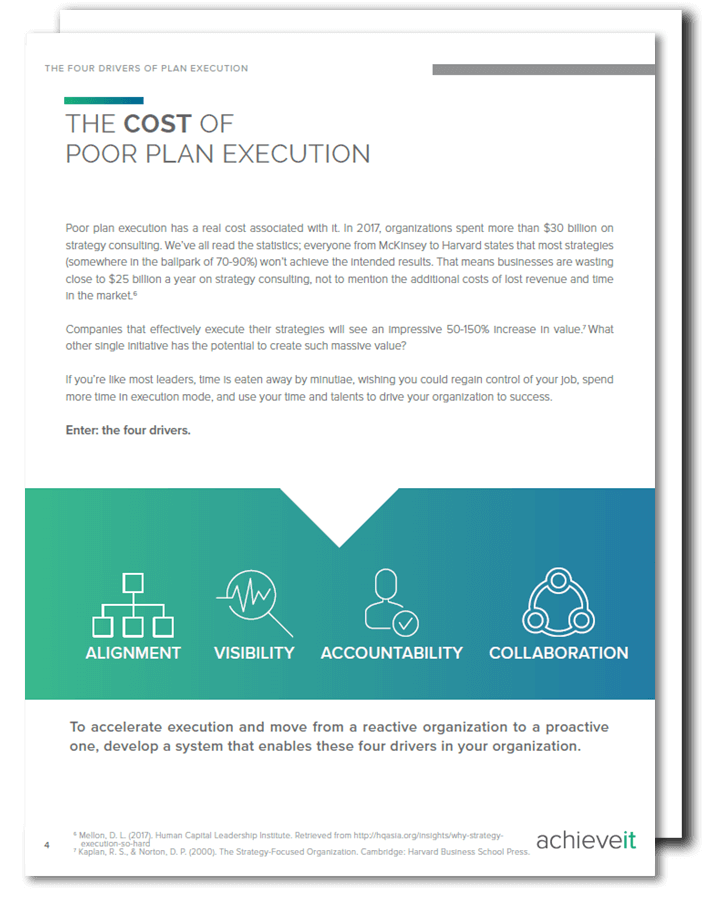
How Business Process Reengineering Can Benefit Your Government Agency
Whether your agency falls under the state/local government or the federal government, there are always opportunities to improve the outcomes of strategic plans and initiatives. Here are 10 ways your government agency can benefit from reengineering some of its processes.
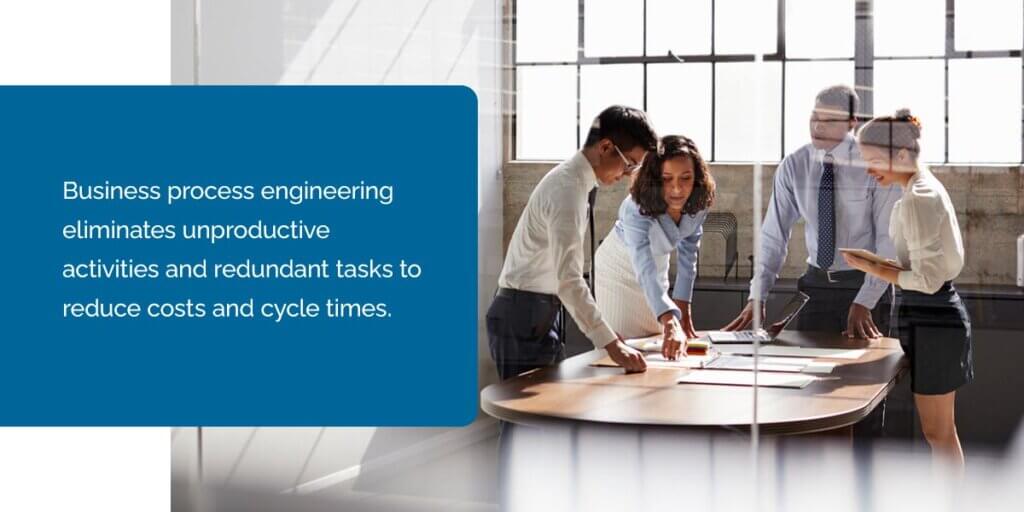
1. Reduce Costs by Eliminating Unproductive Activities
Business process engineering eliminates unproductive activities and redundant tasks to reduce costs and cycle times. With newly designed processes, your agency can work faster and smarter and reduce the amount of time wasted on tasks that get handed off to multiple people. BPR also allows your agency to reorganize your teams to eliminate job repetitions, such as having several team members assigned to a task that one or two people can manage, to reduce errors and focus on accuracy.
2. Accelerate Information Access to the Right People
Implementing BPR in your agency will help accelerate the flow of information across the organization and improve lines of communication for goals and projects. With efficient business processes leading the way, your teams can more easily collaborate with one another to facilitate teamwork and ensure each task is properly completed.
Improved processes will also enable employees to find the information they need and distribute the data when necessary. This can make individuals, teams, partnerships, and customer relationships stronger.
3. Make Your Team More Flexible
BPR prepares your team to adjust, adapt, and be more agile to new processes. This means they have a better idea of maintaining efficiency after implementing new changes. As a government agency, you may regularly face the need for change because of industry demands, technology innovations, and new regulations. BPR promotes flexibility within your organization and allows you and your employees to customize your processes to your agency’s needs.
4. Improve the Quality of Your Service
By simplifying who does what in your agency, you can increase accountability among workers and enhance management and customer feedback to continuously improve the quality of your service. BPR enables your team to establish clear ownership over specific processes and gain responsibility for their output. This makes it easier for them to work with management to measure their performances and maintain a high level of quality.
5. Enable Innovation
A key goal in any agency is innovation. With more streamlined, enhanced processes, you and your employees will benefit from more focused goals and improved effectiveness. This allows you to put more time and energy into building relationships with your customers and ensure you deliver better results.
Likewise, improving innovation and communication between cross-functional teams can make your agency more resilient to changes or unexpected issues. Innovation is a critical feature that strengthens organizations to solve problems and develop new ideas in these situations.
6. Support Your Project Goals
Consider the most important project goals in your government agency. How can you support those goals if you don’t know where your organization stands and what needs to change? BPR allows you to analyze every fundamental process in your business to determine how to reach your goals more effectively.
Whether you want to optimize your customer service or improve your information technology capabilities, it’s essential to understand whether your current processes align with these goals. By using the structures of BPR, you can identify which methods to redesign and what software or resources you need to implement these changes successfully.
7. Provide Clarity of Purpose
Many businesses and government organizations may be unable to list and describe all of their processes from end to end. This is understandable in a large or federal agency due to many high-profile and compliance-related functions. However, BPR implementation empowers organizations to grasp the current state of their processes and find gaps between strategic initiatives and prospective goals.
After all, your team can only put their best efforts into these new processes if they are clear on the purpose of your desired results. Successful BPR helps you and your team automate the right things, reduce the risk of costly errors, and aim toward your desired output.
8. Increase Operational Efficiency
Regardless of industry, improving operational efficiency is something every business aims for. As you redesign your current workflows, your agency may naturally identify ineffective processes that have led to operational and communication breakdowns in the past. Additionally, you may encounter unnecessary steps that frustrate your team and customers instead of adding value to your organization.
When you reengineer these functions, you can find ways to eliminate these day-to-day complications and improve efficiency across the board. From there, you can implement new software and tools that enable you to automate tedious processes so your employees can move through tasks easier and faster.
9. Amplify Transparency and Consistency
In public organizations, there are certain industry regulations you need to comply with. Government process improvement can help your agency remain transparent, consistent, compliant with regulatory requirements, and avoid fines or penalties. You can improve visibility across the entire organization by redesigning your existing functions and integrating accountability and compliance into the process life cycle.
Likewise, your employees can execute every designated task precisely the way you planned and designed it to ensure they are handled appropriately each time.
10. Maximize Your ROI
Reengineering government processes, combined with the benefits above, can maximize your agency’s return on investment (ROI) and reduce frustration among your employees and teams. Improving your processes by making drastic changes can always seem like a risk. But, the business benefits that evolve can bring you closer to your goals and empower you to provide better service to your customers. By preparing and designing these processes through BPR, you may be able to move through the implementation phases faster and see high ROI for your agency.
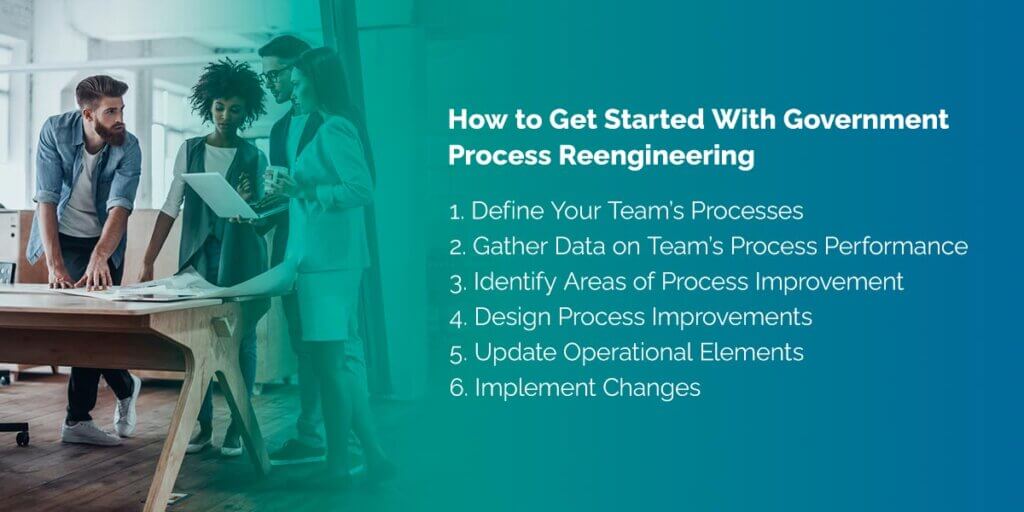
How to Get Started With Government Process Reengineering
Because BPR exists in all kinds of industries, the exact process within your government agency or organization may vary. Here are six general steps to help get you started with a government process reengineering strategy in your agency.
1. Define Your Team’s Processes
In this first step, map out the current state of your organization, including:
- Business rules
- Supporting technology
- Roles and reporting relationships
- Work activities and workflows
By seeing these processes on paper, you can identify and communicate the issues holding your agency back. Pointing out logistical problems can also help you locate the cause of these challenges and work to resolve them.
2. Gather Data on Team’s Process Performance
Next, your government organization should measure how well you’ve been performing in these specific areas. This step aligns with the previous one because it enables you to find strategic disconnects between your performance and the obstacles you’re facing. Within your government agency, you may already see this type of performance measurement at regular intervals, but if you can’t connect it to the root causes of the issues keeping you from improvements, this information isn’t as valuable.
By gathering data on each team member and your agency’s overall performance, you can see in real-time how industry challenges and internal hindrances are affecting your organizational success. This can allow you to work on operational efficiency and design more strategic objectives for the future.
3. Identify Areas of Process Improvement
After conducting a gap analysis and identifying root causes and areas of improvement, it’s critical to analyze and validate opportunities to address these issues. As a best practice, you’ll want to focus on improvement opportunities that are more forward-thinking than your current processes. This may allow your agency to adapt to transformational strategies without getting stuck in a similar rut down the line.
For example, is your government agency looking to enhance transparency, accountability, technology, or responsiveness? A great way to track these areas of process improvement is with key performance indicators (KPIs). A KPI is a measurement tool that can help you achieve your organizational goals, such as improving cyber security or reducing energy expenses.
4. Design Process Improvements
Once you identify and implement KPIs that work for your government agency’s goals, you can work on designing and developing different solutions, review them with your team, and discuss the benefits and drawbacks of each factor. In addition, you’ll want to select the improvement opportunities that will have the most impact on your operational efficiency and ensure your agency has the time, budget, personnel and other resources to implement them in the desired timeframe.
At this stage of BPR, your organization should be able to visualize the changes you want to see and design reasonable, effective methods for these improvements.
5. Update Operational Elements
Before you can implement your changes, they must be operationalized. Jumping from design to implementation can create high hopes and failed strategic initiatives. Remember, your agency will be redesigning its entire system and fundamental processes, so it’s critical to work out the kinks.
Before introducing new procedures and workflows, you’ll want to enhance their functionalities, ensure you communicate new strategies with your team members, and test your changes ahead of time. By doing so, you can prevent issues when you implement your new solution.
6. Implement Changes
Finally, you’ve arrived at the implementation stage. This is where you will put your future state changes into action and see how they impact your performance, efficiency, and effectiveness as an organization. From here, it’s essential to monitor your performance and look for opportunities to improve project management.
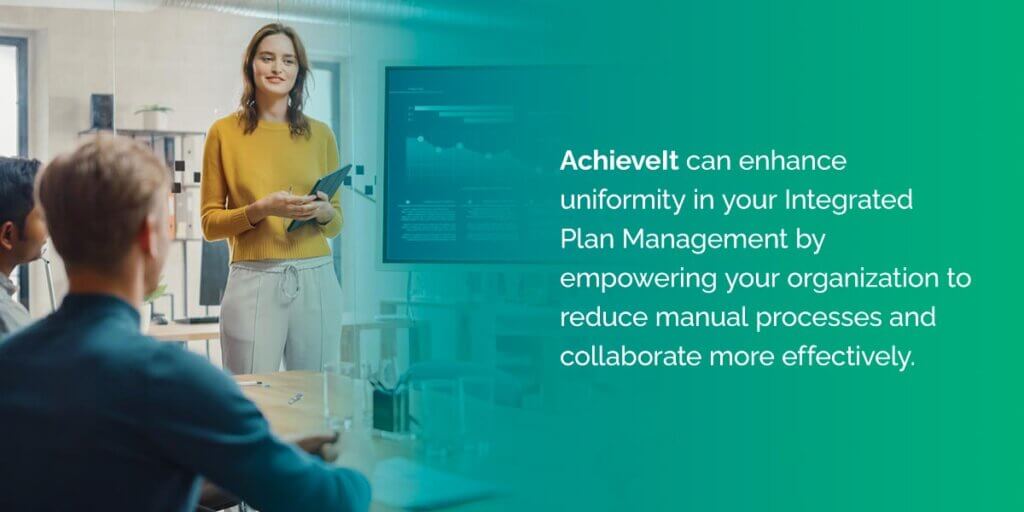
Start Evaluating Your Agency’s Processes Today
There are many critical processes in your government agency you may want to evaluate and improve for efficiency. Without the right tools and resources, this can be a time-consuming challenge. With AchieveIt, you can input and execute your key plans and initiatives through a single, automated platform.
Within the AchieveIt system, your agency can connect, manage, and assign tasks and updates to individuals across the organization to increase visibility and accountability with your BPR processes. This platform also enables you to request updates that will automatically flow into any dashboards or reports that display both quantitative and qualitative data of your choosing.
AchieveIt can enhance uniformity in your Integrated Plan Management by empowering your organization to reduce manual processes and collaborate more effectively. To take your plans from paper to reality, schedule a demo or contact us today to learn how AchieveIt can increase alignment within your government agency.



